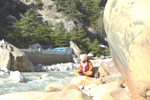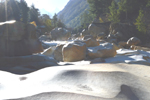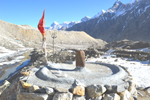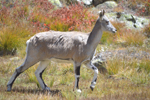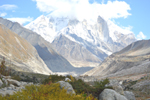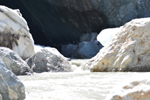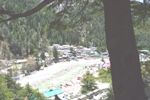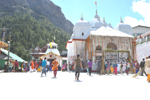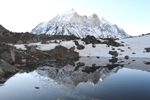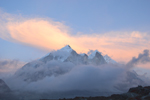Gangotri, Gomukh & Tapovan
Gangotri is a small mountain village in the Uttarkashi district of the Garhwal region of Uttarakhand state, located on the banks of the Bhagirathi River, within the High Himalayan Range at an altitude of 3042m. Gangotri is an important pilgrimage center of the Chhota Char Dham -Yamunotri, Gangotri, Kedarnath and Badrinath.
Gangotri is the last settlement in front of the homonymous glacier, one of the largest glaciers of the Himalayas, from where Bhagirathi appears. Bhagirathi is one of the three rivers (Bhagirathi, Alakananda and Mandakini) which form the sacred Ganga on merging near the town Devprayag. That part of the Gangotri glacier, where Bhagirathi appears, is called "Gomukh", which in Hindi means "Cow's Mouth". It is Gomukh, located at the distance of 19 km from Gangotri at the altitude 3800 m at the foot of the Shivlinga peak (6543 m) and the Bhagiratha peak (6856 m), which is the highest goal of every pilgrim coming to these places. No other river of the world has such huge religious and spiritual significance as Ganga. Ganga - this is the female energy of all living things on Earth.
King Bhagirath’s penance
The Bhagirathi River is named after the great king Bhagiratha, who according to legend brought the Ganges from the spiritual world to Earth. The most complete description of the legend of Bhagiratha is contained in the holy Ramayana. It is said that Bhagiratha was the ancestor of Lord Rama, a descendant of the great emperor Sagara of the Solar Dynasty and the ruler of the ancient Indian kingdom of Koshala. Mahabharata also tells about the descent of the heavenly Ganga to earth. King Bhagiratha wanted to help his ancestors who could not attain libeation due to Kapil Muni’s curse. He began extreme austerities as an ascetic at Mt Himavan in the Himalayas to please Lord Vishnu. When a thousand heavenly years passed, Vishnu ji appeared to him, pleased with the ascetic feat of the king, and asked what he wants. The king requested Him to release the Ganga from His feet onto earth so its water could wash his ancestors’ ash and cleanse them of their sins: “So raise my ancestors, the sons of Sagara, to heaven, I cry out to you with a prayer only for the sake of them!” Ganga agreed to fulfill Bhagiratha’s desire, but asked him to propitiate Lord Shiva with his asceticism and plead him to help mellow the powerful flow of her stream falling from heaven lest the earth be destroyed. Bhagiratha went to Mt Kailash and appeased Lord Shiva. So Ganga, daughter of Himawan, came down to earth in our world. It is believed that the deity of Ganga stays here, in Gangotri.
Main attractions
The main attraction of this sacred place - Gangotri Temple (Temple of the Ganga Goddess) situated in the center of Gangotri , built by the Gorkha military commander Amar Singh Thapa in the 18th century. (Gorkhi or Gurkhas are a warlike people living in Northern India and Nepal and named after Guru Gorakhnath or Gorakshanath - a saint and philosopher who lived in the 11th-12th centuries, a representative of the Nath tradition). It was restored by the Maharaj of Jaipur in the 20th century, who added elements of Rajasthani architectural style. Inside the temple there is a silver idol of goddess Ganga. Gangotri Temple is small. The snow-white facade of the temple is the main decoration on the background of blue sky, dark rocks and greenery of pines. Nearby, there is a Shila or sacred stone where, according to legend, King Bhagiratha prayed to Lord Shiva.
Every year from May to October, many pilgrims visit this holy place. By November, Gangotri is covered with snow and becomes empty, only a few sadhus stay here in the bitter winter. After Diwali celebration, the idol of Mother Ganga is brought down to the Mukhba village. She returns to Gangotri in the spring on Akshaya Dvitiya. The next day - AkshayaTritya - a holy day of the Hindu calendar (usually falls in the second half of April) marks the beginning of ice melting and the opening of temple in Gangotri. The return of goddess Ganga to Gangotri is being celebrated with great tradition uninterrupted for more than 700 years. The goddess is dressed in red-green clothes, carried on a palanquin, making a journey of 25 km.
There are ghats on both banks of the Bhagirathi. Steps lead down to the main ghat, where pilgrims take bath in the icy waters of the river to cleanse their bodies and souls from sin.
One of the pearls of Gangotri is rightfully the GauriKund waterfall. The glacier tongue was in this in the Vedic times. The play off of sunlight on the water droplets spraying from the fall form rainbow throughout the day. The state government has built an embankment here, with steps for visitors to sit and enjoy the waterfall.
The high-altitude Kedar Tal (lake) situated around 18 km from Gangotri, located opposite the snowy peak of Thalyasagar, at an altitude of 4425 m. The crystal clear water of the glacial lake Kedar Tal is considered sacred, because according to legend they were formed from snow melted by Lord Shiva. Here, at high altitude, the lake with blue waters is surrounded by green forests where Bharalas (blue sheep), Himalayan bears and snow leopards live. The path to Kedar Tal Lake is difficult; it runs through difficult mountain trails and requires a professional guide.
Moving from Gangotri through a beautiful pine forest past the caves - sadhu's houses - one can reach Pandava’s cave. It is believed that the heroes of the Mahabharata, the Pandava brothers, visited this place before leaving our world. It is a very strong spiritually charged place and it motivates to meditate. When I visited the Pandavas’ cave it was inhabited, a sadhu lives in it.
Gangotri is a famous place of the very big power, where the vibrations (breathing) of the Mother - Earth are felt on a high physical level, nature here is one big Temple where everything is connected in great harmony, like her beloved child.
GOMUKH
Trekking to Ganga's source along the trail a pilgrim can ride on horse or palanquin, but it is more important to walk this path by foot, step to step, to feel every meter of this spiritual path.
The ascent leading to the glacier is not too difficult; the elevation angle is about 10 degrees. The road is equipped and the Indian government maintains it in good condition. Several green zones gradually change along the path - forests turn into rare thickets, and then completely disappear, leaving only stone blocks and magnificent views around.
Bhojvasa (3800 m high) is situated 5 km from Gomukh, here pilgrims and trekkers usually stop for the night and restore strength before the last 5 km to Gomukh and 8 km to Tapovan. A wonderful panorama of the Bhagirathi Peak opens from here.
The place is breathtaking! It is a blessing that the Universe allowed this gift for us - to come here on our own feet, see everything with our own eyes and feel the powerful energy in every cell of the body. The energy of this place is so powerful that no words will be enough to convey this state; it is as if you are dissolved in this stream. It feels like being in heaven.
TAPOVAN
Tapovan (Sanskrit) comes from the two words, tapas - meaning penance and austerity, and more generally spiritual practice, and vana, meaning forest or thicket. Tapovan then translates as forest of austerities or spiritual practice.
Climbing the Tapovan plateau (4450m), the first thing you can see is Shivlinga Mountain (6547m) and Bhagirathi’s sister tributaries. Sometimes we feel the Bhagirathi sisters are even grander than Mt Shivlinga, because the three of them form a massif, which dominates the landscape. The famous Mt Meru and Manda Parbat are visible as well.
You only reach here by the highest Grace and permission of the Universe, and it is here one can begin to understand what perfection or completeness is. The first thing you do is listening to the silence - so quiet that it’s hard to imagine. The noise of Bhagirathi remains below the body of the glacier.
There are no trees there. This is the kingdom of stones, rocks, flowering meadows, Bharalas (blue sheep) and multi-colored lichens. They create such a variety of patterns that it excites the onlookers’ imagination. One can understand what a harmonious world this is, which does well without us and we can only get the good pleasure of being visitors there.
A stream called Shiva Ganga (or Amara Ganga) whose water can be used for drinking and cooking flows through the plain. On both sides of the streams are caves, and some of them have been appropriated by sadhus. Tapovan is a great place for high meditation in silence, so some sadhus live here for a long time in mauna (silence).
Author, Raisa Uzhegova, is a spiritual seeker living in Belarus

